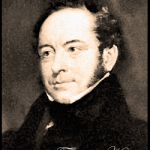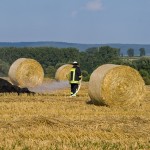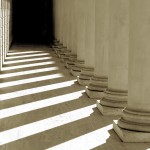Weekly Wrap Volume 93
“Emoticons,” short for “emotive Icons,” (emotive meaning “appealing to or expression emotion” hence “icons that express emotions”) have been around in vertical form for some time. However, sideways emoticons seem to be a surprisingly recent invention, going back just about three decades. “B4″ the days of LOL and apps to aid parents in understanding their teenager’s “textspeak”, a man named Scott E. Fahlman wanted his colleagues and students to understand the difference between a sarcastic joke and a nasty barb when typed. Fahlman was part of a group of scientists and students at… (more)
Have you ever looked at the shiny dome of your grandfather and wondered, “Should I start stocking up on head wax soon?” Statistically at age 30 you will have a 30% chance of going bald. This increases by 10% every 10 years. So someone 50 years old will have a 50% chance of being bald. Due to the genetic factors involved with baldness, it stands to reason, if your grandfather is bald, you too will have to face that demon. Fortunately, scientists have pinpointed the genes responsible and just might have a cure for baldness in the next few years. Hair loss is simply termed “alopecia”. This refers to any type of hair loss no matter the cause. There are numerous things that can cause hair loss, from medical treatments like chemotherapy, to scalp infections and stress. Countless other disease processes can also result in hair loss. The type… (more)
For the uninitiated, cow tipping is a prank where a person sneaks up on a sleeping cow and pushes the animal over onto its side. Ask around and you can probably hear about a friend of a friend who successfully tipped a cow while out in the country late one night. The story generally recounts participants having a few alcoholic drinks before driving to a cow pasture and setting upon a slumbering bovine. But is it really possible to tip a cow? Well, anything is possible and humans are quite inventive, but in the way that cow tipping is generally depicted- no, it is not possible to tip a sleeping cow. The first issue here is that cows don’t actually sleep while standing up, at least not in the way we tend to think of sleep. Cows do sometimes enter a sort of restful state while standing up, but while in this state… (more)
 The Man Who Broke the Bank at Monte Carlo
The Man Who Broke the Bank at Monte Carlo
The Casino de Monte-Carlo is one of the most famous gambling establishments on Earth and as a result is often referenced in various forms of media. Perhaps the most well-known mention of the casino is the song, The Man Who Broke the Bank at Monte Carlo. But who was this mysterious gambler and how exactly did he break the bank? To begin with, we should probably explain what “breaking the bank” means, since there appears to be some confusion around what specifically it refers to in this context. Breaking the bank happens when a gambler wins more money than the table they’re playing at currently has available. While breaking the bank can also technically refer to winning more money than the entire casino currently has available, this is virtually impossible (at least today) for a variety… (more)
 WWII and the Creator of Captain America
WWII and the Creator of Captain America
Jack Kirby was one of the principle minds and artists behind some of the best known comic characters in history, including, among many others, the Fantastic Four, the Hulk, X-Men, and Captain America. Few people realise, though, that like his most patriotic creation, Kirby spent a good portion of WW2 fighting the Nazis as well, though never managing to duplicate Captain America’s feat of punching Hitler in the face. Kirby was drafted into the army in June of 1943, just as his comic career was starting to gain some serious traction, and was initially assigned to be trained as a mechanic. However, according to Kirby’s son, Neal, his father had absolutely no affinity for the finer points of mechanics and spent as much of his training as possible lying below a truck and… (more)
This Week’s YouTube Videos (Click to Subscribe!!):
- What Causes the Smell After Rain?
- Did Nero Really Fiddle While Rome Burned?
- When Did People Start Smiling in Photographs?
- Steve Jobs’ Illegal First Business
- The Homicidal Origin of the Phrase “Run Amok”
- Olympic Tug of War and 8 Other Fascinating Quick Facts
- Water and Vodka and 12 Other Language Facts
- The Fascinating Origin of Scrabble
- Why We Brake Champagne Bottles on Ships
- How 911 Became the Emergency Number in the United States
Bonus Quick Facts:
- October got its name from the Latin “octo”, meaning “eight”. If this seems odd to you, considering it’s the tenth month in the modern day calendar (Gregorian), that actually used to not be the case. It was once the eighth month (in the Roman Calendar) and the name simply carried over.
- The word blond derives from the Old French word “blund”, meaning literally “a color midway between golden and light chestnut”. “Blund” is typically thought to have come from the Latin word “blundus”, which was a vulgar pronunciation of the Latin “flavus”, which means “yellow”. The French origin of the word “blond” is how we get the added “e” on the end when using the feminine form of blond.
- WD-40 got its name from the fact that it was the 40th try at creating a water displacement substance.
- The name “tetris” derives from the Greek prefix “tetra-” (because the game pieces are all tetrominoes) and the latter “-is” is from “tennis”, which is the primary creator of Tetris’, Alexey Leonidovich Pajitnov, favorite sport. Tetrominoes are four element polyominoes. Polyominoes are known to have been used in puzzle games for at least 90 years (and most likely much further back than that) at the time Pajitnov developed Tetris at the Dorodnicyn Computing Center, which was a part of a Soviet government funded research center in Moscow, called the Soviet Academy of Sciences. Because he developed the game while working here, for a long time, the rights to the game were owned by the Soviet Union government.
- The term “baker” dates back to around the year 1000. Another term that meant the same thing from that time was “bakester”, referring to female bakers; this is similar to how a “webster” was a female weaver, with the “-ster” ending implying a woman. “Bakester” is also where the surname “Baxter” comes from.
Other Interesting Stuff:
 Two Guys and One of the Greatest Practical Jokes of All Time
Two Guys and One of the Greatest Practical Jokes of All Time
The year was 1809. Famed English author, Theodore Hook, made a bet with one of his close friends, the noted architect and writer, Samuel Beazley, that within one week, he could make any house in London the most talked about place in the city. The house he ended up choosing was the home of the widow Mrs. Tottenham on 54 Berners Street, London, which was the same street that Earl Stanhope and the Bishop of Carlisle and of Chester, among other wealthy and well-to-do individuals, lived on at that time. It isn’t known why Hook chose Mrs. Tottenham’s home as no connection between the two is known and Hook himself never explained his selection. It’s entirely possible that it just happened to be a location where the home across the street could be rented and was also in a fairly well-to-do part of town which would help assure Hook’s plan would work. Whatever the case, the event began on November 27th. Hook and Beazley positioned themselves in the home across the street and around 5:00 am… (more)
Two foods are left out on the counter – fresh tomatoes and a bowl of sugar. Within a week or so, one will develop black spots and the other remains pristine, albeit perhaps a little clumpy depending on the humidity of the air. The reason? Osmosis. While microorganisms love sugar, they also need a certain amount of water to thrive. This level of freely available water, called “water activity (aw),” for bacteria is about 0.91, for molds it is 0.8 and for fungi (yeasts), it must be at least 0.6. The aw of fresh foods is generally about 0.99, while crystalline sucrose (table sugar) is a paltry .06. In its crystal form… (more)
 Why Does Moist, Baled and Stacked Hay Spontaneously Catch Fire?
Why Does Moist, Baled and Stacked Hay Spontaneously Catch Fire?
Plant reactions and bacterial growth combine to raise temperatures in even the driest hay bales, although most never catch fire on their own. However, when hay is packed tightly, and enough moisture gets in, the conditions may be right for spontaneous hay combustion. How does this work? Bacteria thrive when sufficient glucose (a simple sugar found in plants) is available. In the process of breaking it down into energy, aerobic bacteria catabolize the glucose, turning it into a usable form. Through the process of respiration, these bacteria completely oxidize the glucose – transforming it into carbon dioxide, water and energy. This last is released as heat. Likewise, even after it’s cut, the cells… (more)
 Myth or Fact: Women’s Menstrual Cycles Synchronize if They are in Close Proximity for Large Amounts of Time
Myth or Fact: Women’s Menstrual Cycles Synchronize if They are in Close Proximity for Large Amounts of Time
Do women’s menstrual cycles sync up over time if they are in close proximity to each other? Being someone who lives with 4 girls and 1 other boy, this knowledge would be very beneficial. I feel like I should know if the estrogen ocean I’m swimming in will have very stormy seas every 28 days. The belief that this occurs is widely known. In 1999, one study reported that 80% of women believe this phenomenon occurs and 70% of them find it pleasant to have this be the case. The truth, like so many other things in science, is controversial. The main body of evidence, however, suggests this is nothing but a myth and it’s really just random chance when this synchronization is occurring. Let’s find out why. A woman’s menstrual cycle is counted from the first day she begins menstrual bleeding until the first day of the next menstrual bleeding. This cycle can vary… (more)
 The Man Who Accurately Estimated the Circumference of the Earth Over 2,000 Years Ago
The Man Who Accurately Estimated the Circumference of the Earth Over 2,000 Years Ago
Born around 276 B.C. in Cyrene, Libya, Eratosthenes soon became one of the most famous mathematicians of his time. He is best known for making the first recorded measurement of the Earth’s circumference, which was also remarkably accurate. (And, yes, people at that point had known for some time that the world wasn’t flat, contrary to popular belief.) Eratosthenes was able to accomplish this in part because of his education in Athens. There, he became known for his achievements in many different fields, including poetry, astronomy, and scientific writing. His activities became so talked about, in fact, that Ptolemy III of Egypt decided to invite him to Alexandria to tutor his son. Later, he would become the head librarian of the Library of Alexandria. The mathematician must have been thrilled to have this opportunity. The Library of Alexandria was a hub of learning at the time, attracting scholars… (more)
| Share the Knowledge! |
|








